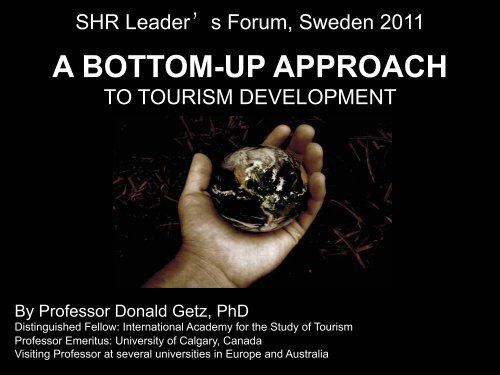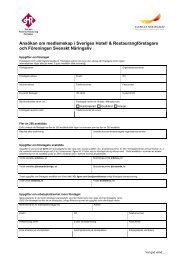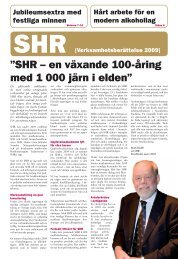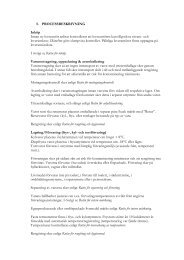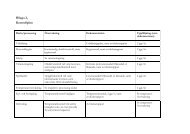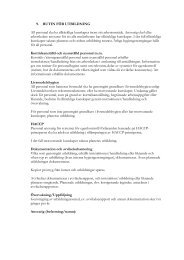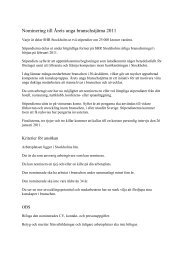A BOTTOM-UP APPROACH - Visita
A BOTTOM-UP APPROACH - Visita
A BOTTOM-UP APPROACH - Visita
You also want an ePaper? Increase the reach of your titles
YUMPU automatically turns print PDFs into web optimized ePapers that Google loves.
SHR Leaders Forum, Sweden 2011A <strong>BOTTOM</strong>-<strong>UP</strong> <strong>APPROACH</strong>TO TOURISM DEVELOPMENTBy Professor Donald Getz, PhDDistinguished Fellow: International Academy for the Study of TourismProfessor Emeritus: University of Calgary, CanadaVisiting Professor at several universities in Europe and Australia
INTRODUCTIONTraditional, top-down planning and decision-making:• is increasingly viewed as being unresponsive to changesin the marketplace• is not efficient enough when it comes to realizing thecompetitive potential of private enterprises• is based on the belief that tourism can be controlled andpredictable• is ineffective in stimulatinginnovation and entrepreneurship• poses difficulties in measuringmacro and micro level return oninvestment.
TOP-DOWN planningand decision-making:• is associated with centralized regimes, statebureaucracies, and control.• the Emirates for instance,have achieved a great deal withtop-down development, butis this level of capital investmentsustainable or transferable?
SWEDENS NATIONAL TOURISMSTRATEGY CONTAINS:• Three Focus Areas(1) Destination development and themes; (2) Offensive marketingand sales; (3) Coordinated tourism industry• Four Strategic Goals(1) Increase number of international visitors; (2) Develop severalnew and support presentdestinations; (3) Increaseeconomic impact; (4) Increasenumber of domestic visitors• Six Strategies(1) World-class destinationdevelopment; (2) Financing;(3) Private-public partnership;(4) Target marketing; (5) Entrepreneurship, business enterpriseand competence; (6) Green and sustainable tourism development
CHALLANGES WITH aTOP-DOWN <strong>APPROACH</strong>• Most tourism plans donot work becausetourism is too complexfor the deterministicmodel.• Failure to create orfacilitate new touristexperiences.• Tourism actors conductbusiness in isolation,avoiding cooperativestrategies.• Does not encourageidentification of newtarget markets.Developed by Getz and Vujicic (2010)
MORE CHALLANGES WITH aTOP-DOWN <strong>APPROACH</strong>• Ignores the potential and needs oflocal and small entrepreneurs.• Competition for money, andover-lapping actions betweendifferent tourism and otherpublic organizations.• Structural problems, and a lot ofbureaucracy.• Inability to analyzethe interrelationship betweentourisms components.
IMPLEMENTING the<strong>BOTTOM</strong>-<strong>UP</strong> <strong>APPROACH</strong>• It is not so much aprogram as aphilosophy.• Whatever theexisting frameworkfor tourism policy,planning anddevelopment, a morebottom-up approachcan be implementedto some degree.Developed by Getz and Vujicic (2010)• The followingprinciples should beadopted forapplication inSweden.
1: LIBERATE INNOVATION• Tourism as an industry is typically conservative, slow tochange or innovate.• Most innovation will come from the local level, from newnetworks and collaborations, and from entrepreneurs.• Stakeholders* need resources, incentives and advice onhow to respond to challenges and new opportunities.• Constant knowledge creationand rapid spread ofinnovation is essential.* Any group or individual who can affect or is affectedby the achievement of the firms objectives (Freeman,1984:25); constitutors who have a legitimate claim onthe firm (Hill and Jones, 1992:133).
2: EMERGENT STRATEGY• Shift the emphasis towards implementing strategies thatemerge from successful initiatives.• This recognizes that it is difficult or impossible to predictwhat will work in the future, or what new opportunities canbe seized by an innovative,dynamic tourism sector.• The problem with fixedstrategies and long-termplans is that they get outof date very quickly.
3: MORE S<strong>UP</strong>PORT FOR ENTREPRENEURSand SMALL BUSINESS• Instead of subsidies and protectionism, support networks,innovative product development and niche marketing.• Must be convinced that collaboration works better thancompetition.• Local authorities and DMOs*must be more proactive inassisting entrepreneurs.• Entrepreneurs are mostlikely to co-create newtourist experiences.* Destination Marketing/ManagementOrganization
4: DEVELOP GLOBALLY COMPETITIVECLUSTERS• Globally competitive clusters should be fostered where highpotential exists.• Clusters bring together a mix ofstakeholders, in one area, as a strategicalliance, for mutually-reinforcing businesslinkages; new synergies are created.• Identify destinations with the greatestpotential in terms of existing resourcesand potential experience-creation fornew target segments.• Begin with local/regional networkingand research, leading to collaboration.
EXAMPLE: HEALTHY LIFESTYLE CLUSTER INSOUTH-EAST ENGLAND• Product Innovations: Identification of innovative products/services- Special interest or niche tourism products• Process Innovations: Performance improvement of operationsalready in portfolio- Use of modern approaches and information technology• Management Innovations:Collaborative structure leadingto an improved businessperformance and touristexperiences• Institutional Innovations:Stability through institutionalsupport
5: ENCOURAGE PRODUCT CLUBS• Tourism product clubs do not have to be localized.• They usually resolve problems that represent barriers toproductivity and business efficiency.• They permit formalization of collaborative actions amongstakeholders in the development, of the sector, topic or niche of thetourism market.- Establishment of commercialsynergies among participants.- Potential increase of the market ofa topic or niche.- Foster innovation that can becommunicated to the whole industry.
6: MORE FOCUS ON SPECIAL INTERESTSEGMENTS and EXPERIENCES• Traditional tourism planning is centered on supply, and inmatching existing supply with existing demand.• A bottom-up approach is demand oriented and seeks outspecial-interest segments.• There is limited potentialfor growing mass markets.• New, highly targetedexperiences have to becreated.
BM boundary. Hence, according to the fundamental hypothesis, loadings of thegrowth calendar portfolio on the Growth and Value indices should be similar tothose of the value calendar portfolio. According to the label hypothesis, however,loadings of the growth calendar portfolio on the Growth index should be higher thanthat of the value calendar portfolio, simply because stocks in the growth calendarportfolio are labeled as Growth stocks. Similarly, the value calendar portfolio shouldload more heavily on the Value index. In summary, using the control sample I find nosignificant difference in index loadings across calendar portfolios. For the test sample,however, I find the loading of the growth calendar portfolio on the Growth index tobe significantly larger than that of the value calendar portfolio, and the loading ofthe value calendar portfolio on the Value index to be significantly larger than that ofthe growth calendar portfolio. These differences are not only significantly differentfrom zero but are also significantly different from the identical measures estimatedusing the control sample, again indicating the fundamental hypothesis should berejected in favor of the label hypothesis.I also ensure the results of Table II are not driven by nonsynchronous trading(Lo and MacKinlay (1990)) using three different methods. First, I create the resultsof Table II after removing stocks that tend to have stale closing prices. I use theTAQ database to determine the time of each closing price for each stock that switchesamong the S&P/Barra indices on each day. I remove a stock if more than five percentof its daily closing prices are recorded earlier than 3:45 PM during the pre-or postevent window for that stock. Second, I estimate average changes in comovementas in Table II using weekly rather than daily data. Third, I investigate changes inaverage comovement after including lagged index returns (four lags) in the regressiongiven in (1). For all three experiments, results are very similar to those in Table II.Moreover, the third experiment provides little evidence that cross-autocorrelationschange when a stocks switches to a new index.Finally, I estimate changes in univariate measures of comovement between indexswitchers and each index (correlation and univariate regression slope) and find similarresults as in Table II. When a stock switches to the Growth (Value) index, its correlationand slope coefficient with the Growth (Value) index significantly increases.15
EXAMPLE: FOOD TOURISM• Although a great deal is known already about the supply side,focused research on the potential to develop relevant specialinterestsegments (that is, foodies) has not been conducted.There is a need to....- profile those most likely to travel for food experiences.- assess interest in specific Swedish cuisine, destinations andexperiences related to food.- learn their Information seekingand packaging preferences.- understand the connectionsbetween food and other specialinterests such as yachting,fashion, outdoor recreation,heritage sites, or music.
8: SPECIAL EVENTS• One of the most liberatingbottom-up strategies is toencourage and support specialeventinitiatives.• Every community and specialinterestgroup in the country canbecome involved in bidding onevents and creating new ones.• Events are excellent ways tocreate experiences sought byspecial-interest segments, suchas food and wine lovers, culturaltourists, and outdooradventurers.• Support from a national eventdevelopment corporation wouldbe highly effective.
EXAMPLE: THE ÅRE HALLMARK EVENT PROJECT• Attraction: of new, preferably foreignsegments.• Image: by definition, a Hallmark event mustbe co-branded with the destination andprovide positive images.• Organization and ownership: where doesthe investment come from, and whois to own and produce the event(s)?• Community: the residents must benefitand the event(s) must be green andsustainable.• Marketing: both targeted to new,special-interest segments and to those whoalready know Åre but are not comingbefore Christmas.Photo: Göran Assner/VIEW
9: MORE TARGETEDCOMMUNICATIONS• A focus on niche markets requiresnew ways of communicating,including the use of socialnetworks.• The channels of communicationsand their effectiveness must beconstantly evaluated in a fastchangingworld of technology andcompeting experienceopportunities.• For example, messages and mediaused to reach foodies must bedifferent from those employed toattract sport participants.• Product clubs and clusters willinnovate, test and communicateresults to the entire industry.
10: MORE EMPHASIS ON LOCAL andREGIONAL DMOs• Most innovation and new products will emerge at thelocal and regional levels.• Local (sometimes regional)DMOs are best placed tosustain networks, formcompetitive clusters,and respond to opportunities.• Most travel is city-based;cities are destinations and gateways,as well as showrooms for nations.
EXAMPLE: CALGARY• Tourism Calgary takes the lead informing new alliances to createnew experiences.• The Goal: innovate, overcomeseasonality in demand.• In 2010 Mozart Festival involvesrestaurants, symphony orchestra,and many other partners.
11: INCREASED ROLE FOR RESEARCH• Innovation will require focused and timely research.• Innovation depends upon learning systems being in place.• Partnerships betweenresearchers, industrynetworks and DMOsmust be strengthened.
NEW ROLES FOR THE STATE• Stakeholder planning (not top-down)• Invest in innovation (knowledge creation and transfer)• More of private-public partnerships• Support the development of local and regional networks(DMOs)• Infrastructure investment
Recommended Top-Down and Bottom-Up Initiatives:TOP-DOWNINITIATIVESFollow Emergent StrategyFunding: Networks, clusters, product clubsCapital investment through private-public partnership• Stress Entrepreneurship and small businesses• Research: To support special-interest marketing• Event Development: National bids and• support for local initiatives• Destination development in• private-public partnership• Learning Networks• Product Clubs• Clusters• Experience Design• Pursue new special-interest segments• Special Events<strong>BOTTOM</strong>-<strong>UP</strong>INITIATIVES


